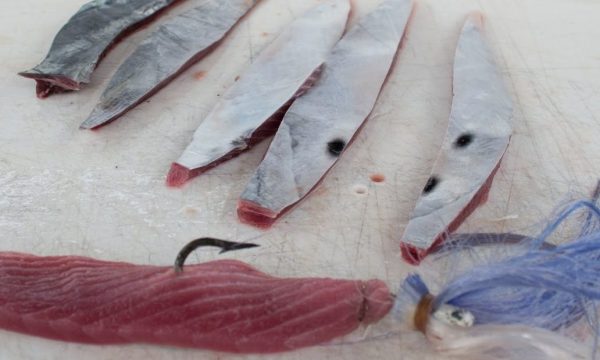Although much more popular on the east coast, using strip baits to entice bites are an integral part of most saltwater fisheries along both U.S. coasts. By using strip baits, anglers can increase their catch when conditions are right.
The ability to trigger the feeding mechanisms in gamefish rely on the profile, action and scent. The fluttering action coupled with a familiar scent (aka “things they eat”) make these types of baits irresistible to most gamefish. Here are four tips to make it happen.
Use What Works
There are a variety of baits that can be used, with squid strips being the most popular, but also including bunker, bluefish, mackerel, and salmon bellies. Most legal fish species can be filleted, cut into desired lengths, and used as strip baits. Bait lengths can vary from 4 to 12 inches depending on the target species and the bait being mimicked. In some locations and seasons, 4 to 5 inch strips will successfully mimic young of the year baitfish, while at other times bigger strips will need to be used to target legal sized gamefish.
Placement on the Hook
A common mistake among novice fisherman is hooking the strip bait multiple times, and this will cause the bait to not “swim” properly. It always will greatly increase the chances of foul hooking. Strip baits should only be hooked once as this maximizes it’s inherent fluttering effect and minimizes any twirling action. The bait will properly swim through the water and impart good action.
Ways to Improve the Bait
Strip-baits are great when the bait is freshly cut and used right away, but sometimes this may not be feasible due to fishing time constraints. Baits can be pre-cut ahead of time and salted with Sea salt. The salt will toughen the bait up so that it stays on the hook better, but make sure you use a salt that is not iodized as this will make the baits less productive due to the presence of Iodine. Scents are a great option, especially when pre-cutting and freezing your baits. Berkley Gulp and BioEdge have a variety of scents that you can let your baits “marinate” as they sit in the container or bag.
Shape Makes a Difference
One suggestion is to cut the strip baits into “pennant” shaped cuts with one end tapering to a point. This will help the bait sit better on the hook and will maximize the fluttering action. Be sure to hook the bait directly in the center of the wider part of the pennant as this will insure proper swimming of the bait.
So the next time you go to grab a bait, remember these tips to improve your fishing acumen. Proper hook placement, salting, scenting, and the right shape will maximize the potential of your strip baits.
Photo credit: Youtube









